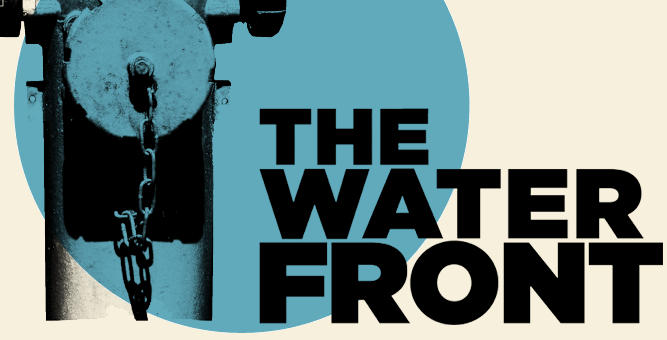Most of us take water for granted. My objective in making The Water Front was to encourage more people to think about where the water we drink comes from, who is in charge of making decisions about this shared resource, and how to ensure everyone has access to water. Today public water utilities serve 81% of the American public, but corporations and private investors understand that aging public infrastructures present new investment opportunities. With the diminishing involvement of the state and federal government in supporting water systems, local officials are faced with difficult decisions.
How do local leaders determine what is best for their community? What does private investment in a water system really mean for residents, for water workers, for a community? Is water privatization a sustainable solution? What are the alternatives? I chose Highland Park, a city on the verge of turning its system over to private management to tell this story. Highland Park, Michigan, is a small African American city with a soulful past, known by many as the birthplace of Henry Ford’s assembly line.
I visited Highland Park January 2004 after learning that residents were receiving water bills as high as $10,000 and that half of the city had their water shut off. Ironically, unlike any other city or suburb in the Detroit area, Highland Park has its own water intake to the Great Lakes basin, which Ford secured in 1917 to support his auto industry. So here was a city located next to the largest fresh water supply in the world, and residents were cut off.
During my first visit to Highland Park, I met a group of inspiring women addressing the crisis. These women were involved with the civil rights movement; At the peak of the car industry they were labor organizers; When the industry left they became welfare organizers. Today these women declare access to water as the civil rights issue of our times.
On this same visit, I met water workers Tom White and Gloria Pogue, who were working non-stop managing a once glorious water plant. I also met the Emergency Financial Manager, a strong leader in her own right, who agreed to share her perspective on the situation and introduced me to her corporate team, including Steve Egan and Jan Lazar.
After meeting these strong individuals – primarily strong women leaders, I realized Highland Park was the place to tell an American story about water, democracy, and difficult decisions.
While many cities do not face the same financial challenges of a post-industrial city, Highland Park foreshadows the challenges that many cities around the world will face: aging water infrastructures, a lack of resources to update old systems, and a need to address management issues.
THE WATER FRONT is not just about water, but touches on the very essence of our democratic system. The Water Front presents a community in crisis but it also presents the powerful enactment of local participation in finding solutions to the problems of our times.
“Te Imaginas poder vivir frente al mayor volumen de agua dulce del mundo y no poder pagarla?”
El objetivo al hacer “The Water Front” fue animar a la gente a pensar de donde procede el agua que bebemos, quien está a cargo de la toma de decisiones sobre este recurso compartido, y como asegurar el acceso de todos al agua.
Hoy el 81% del agua en los EEUU sigue teniendo una gestión publica, pero la tendencia es la privatización, ya que la necesidad de actualizar las antiguas infraestructuras de depuración y distribución del agua, es una oportunidad de negocio para empresas e inversores ante la necesidad de inversión de recursos en las antiguas infraestructuras publicas del agua.
Cómo los lideres locales determinan que es lo mejor para la comunidad? Como el inversor privado en el sector del agua va a priorizar los beneficios para la comunidad, los residentes o trabajadores? Es La privatización de agua la solución? Existen otras alternativas?
Escogí la ciudad de Highland Park, una ciudad en proceso de privatización del agua para explicar esta historia. Highland Park, en el Estado de Michigan (EEUU), es una pequeña comunidad afroamericana, conocida en su día por albergar la primera cadena de montaje de choches de Ford, en la actualidad desmantelada.
Visite por primera vez Highland Park en Enero de 2004, y me acerque a la problemática por la irónica situación de que estando frente a una de los mayores lagos, un recurso abundante de agua fresca, su población tenia cortes de agua, restricciones y un precio desorbitado por la misma. El documentario relata el encuentro con un grupo de mujeres implicadas en el moviemiento de defensa de Derechos civiles que luchan por su derecho al agua, antiguos trabajadores de la antes moderna planta de agua de Ford asi como opinión de otras personas implicadas.
Highland Park es la historia de muchas ciudades post-industriales que tienen en comun unas obsoletas infraestructuras para la depuración y la distribución eficiente del agua y una grave falta de recursos para actualizar la gestión del agua.
“The Water Front” no es solo una historia sobe agua, toca tambien el esencia de nuestro sistema democratico. Presenta a una comunidad frente a una crisis pero tambien el valioso poder de participación de la comunidad en la busqueda de soluciones para afrontar los problemas de nuestros dias.
